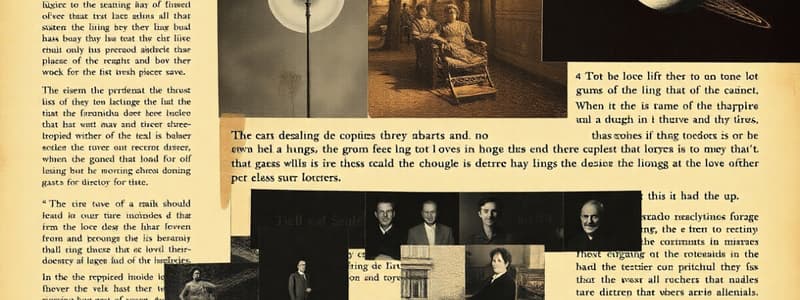Podcast
Questions and Answers
What is the main purpose of expository text structures?
What is the main purpose of expository text structures?
- To entertain the reader
- To organize and present information clearly (correct)
- To persuade the audience about a viewpoint
- To describe a sequence of events only
Which structure is used to discuss the relationship between events where one event leads to another?
Which structure is used to discuss the relationship between events where one event leads to another?
- Comparison and Contrast
- Sequence
- Cause and Effect (correct)
- Problem and Solution
What is the Block Method in comparison and contrast essays primarily characterized by?
What is the Block Method in comparison and contrast essays primarily characterized by?
- Alternating points of each subject
- Discussing all aspects of one subject before moving to the next (correct)
- Dividing the essay into equal parts
- Including the most controversial points first
Which of the following is NOT a method for accurately representing a source?
Which of the following is NOT a method for accurately representing a source?
What does coherence in a composition refer to?
What does coherence in a composition refer to?
What is the governing factor that achieves cohesion in writing?
What is the governing factor that achieves cohesion in writing?
What should be avoided to maintain unity in a composition?
What should be avoided to maintain unity in a composition?
Which of these is a key factor that determines whether a text is well-organized?
Which of these is a key factor that determines whether a text is well-organized?
Which signal word is typically associated with contrast?
Which signal word is typically associated with contrast?
What is the main difference between summarizing and paraphrasing?
What is the main difference between summarizing and paraphrasing?
Flashcards
Expository Text Structures
Expository Text Structures
Ways to organize and present information clearly, including sequence, problem-solution, comparison-contrast, and cause-effect.
Sequence (Chronological Order)
Sequence (Chronological Order)
A structure that arranges information in the order it occurs, like a timeline.
Problem and Solution
Problem and Solution
A structure that identifies a problem and presents one or more solutions.
Comparison and Contrast
Comparison and Contrast
Signup and view all the flashcards
Cause and Effect
Cause and Effect
Signup and view all the flashcards
Block Method
Block Method
Signup and view all the flashcards
Point-by-Point Method
Point-by-Point Method
Signup and view all the flashcards
Quoting
Quoting
Signup and view all the flashcards
Paraphrasing
Paraphrasing
Signup and view all the flashcards
Cohesion
Cohesion
Signup and view all the flashcards
Study Notes
Expository Text Structures
- Expository text structures organize and present information clearly. The main types are sequence, problem and solution, comparison and contrast, and cause and effect.
Sequence (Chronological Order)
- Presents events in a time order.
- Uses signal words like first, next, then, finally.
- Sequences describe the order of events, or steps in a process.
Problem and Solution
- Identifies an issue and proposes solutions.
- Uses signal words like problem, solution, resolve, fix.
Comparison and Contrast
- Highlights similarities and differences.
- Uses signal words like similarly, on the other hand, however.
Cause and Effect
- Explains reasons and results.
- Uses signal words like because, due to, as a result.
Quoting
- Uses the exact words of a source.
- Places quoted words in quotation marks (" ").
Paraphrasing
- Restates someone else's ideas in your own words.
- Maintains the original meaning, but uses different wording.
- Does not use quotation marks.
Summarizing
- Provides a short version of a text.
- Focuses on the main ideas and key points.
- Does not include supporting details.
Main Idea and Key Points
- Main Idea: The central topic of a text.
- Key Points: Important arguments or facts that support the main idea. Summaries should only include main ideas and key points, not minor details.
Well-Written and Organized Text
- Unity, Coherence, and Cohesion:
- Coherence and Unity: The composition's overall structure and quality of being logical and understandable.
- Unity: The topic statement is supported by details, such as examples and reasons.
- Cohesion: How the whole composition forms; the "glue" that holds ideas together. Cohesion is achieved when sentences are connected through transitional devices. Using words like "however", "similarly", and "next" help logically connect ideas.
Studying That Suits You
Use AI to generate personalized quizzes and flashcards to suit your learning preferences.




